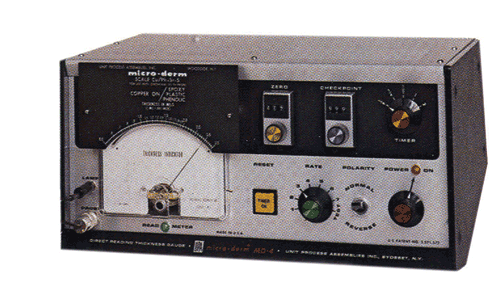
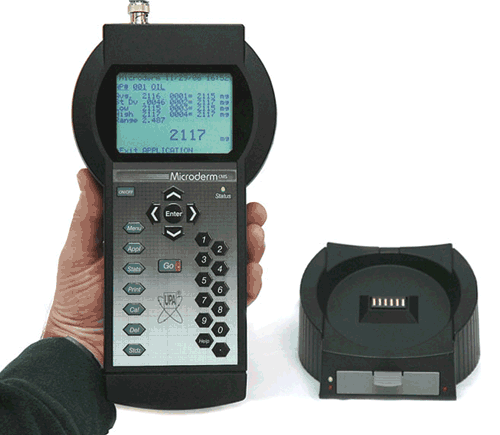
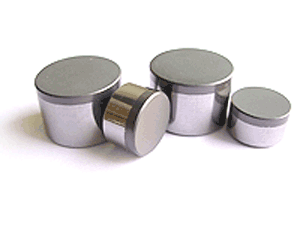
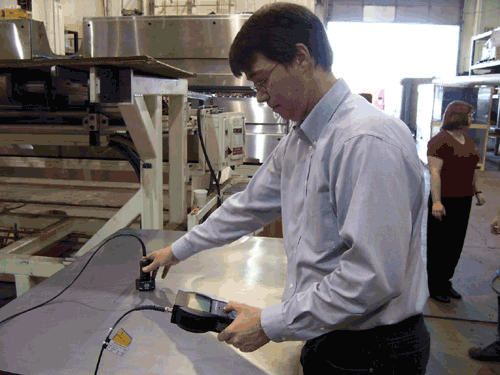
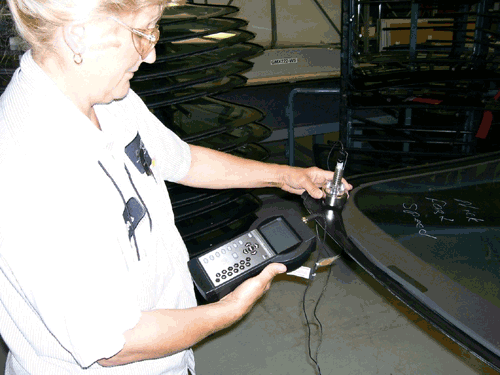
Beta backscatter instruments are capable of non-destructively measuring coating thickness on virtually any substrate that has at least a 20% difference in density than the coating. By emitting beta electrons onto a part, beta systems measure coating thickness by counting the electrons that are back scattered (reflected), thus its name. The number of electrons that are backscattered from the part directly relates to the thickness of the coating. Therefore, the thickness of many platings such as gold, tin, silver, rhodium, or platinum are easily measured by beta backscatter.
Historically, beta backscatter systems were originally developed for—and used extensively in—the measurement of plating thickness on printed circuit boards and electronic components.
Prior to the introduction and commercial availability of beta systems, measurement of thin metal platings was time consuming, destructive, difficult, and often impossible. Basically, either cross sectioning or coulometric instruments were the only means that existed to confirm plating thickness.
These methods were limited to only those parts for which destructive testing methods were acceptable, or in the case of the coulometric method, parts had to be of adequate size and shape to permit the use of this technique. In cross sectioning, technicians had to cut parts in half, polish, plate, and then optically measure the coatings. Imagine the effort that it took trying to measure plating thickness using a microscope to a specification within plus or minus a few millionths of an inch, especially on uneven, irregular substrates or on parts having multiple plating layers.
Before the introduction of beta backscatter, conflict between metal finishers and their customers regarding plating thickness was often unavoidable and not uncommon. The claimed coating thickness was frequently in question because variations induced by technicians would affect measurement results. Plating on electronics components is typically extremely thin—often only at a fraction of a micron—and meeting the thickness specification is critical to the components performance and reliability.
The original introduction of beta instruments by Twin City International of Amherst, N.Y., created an immediate reaction in the metal finishing and manufacturing industries. Upon obtaining a beta system, companies could non-destructively confirm plating thickness within millionths of an inch and in only 10–15 seconds. Process and quality control for coatings thickness measurement had essentially advanced from dinosaurs to Star Wars overnight!
A frenzy was created in the industry, and immediately thousands of beta systems were being delivered annually as metal finishers and PCB and electronics manufacturers all felt compelled to obtain beta backscatter systems.
The original beta backscatter systems were designed using the electronic components available in the 1960s. By today’s standards these early instruments were cumbersome to operate, incorporating myriad dials, knobs, buttons, analog meters, and vacuum tubes. Because little processing power was available for electronics in those days, operators had to actually draw the calibration curves on graph paper and plot their thickness measurements from the bits of information provided by the instrument. In spite of these issues, measurement accuracy was unparalleled and sales of beta systems soared.
Today, X-ray fluorescence instruments have replaced beta backscatter for most electronic and PCB applications due to their non-contact ability to measure multiple layers or alloys on very tiny areas. However, the era of beta system use for coating thickness measurement is far from over.
Recent advances in beta instruments include new, portable systems weighing less than two pounds. The convenience and flexibility of handheld systems has re-energized the beta system market, and the new portable models are rapidly being used by the automotive and appliance industries. Although beta probes operate at a constant 900 volts, these handheld models can measure continuously for up to 20 hours without recharging and require only four off-the-shelf AA batteries.
New Measurement Applications for Beta Technology
Whereas sales of beta backscatter instruments will probably never again reach the levels that they enjoyed during the 1980s, beta backscatter is far from becoming obsolete.
Beta backscatter is re-emerging as an important tool for the measurement of many new coatings, most notably from processes that did not even exist when beta backscatter was originally introduced. It seems hard to believe today, but it was not long ago that we were without cell phones, laptop computers, or the Internet.
As technology advances, new coatings and finishes are being created at an ever-increasing pace. Beta instruments are being used to measure many of these new coatings, ensuring that the need for beta technology will probably never be eliminated.
Several of these new measurement applications are as follows:
- Metal forming lubricants on steel or aluminum
- Sintered diamond coating on tungsten carbide
- Adhesives on automotive glass
- Graphite coating inside nuclear fuel rods
- Stealth coatings on fighter jets and bombers
- Aluminide coatings on jet-engine turbine blades
- Reflective finishes on guidance systems for “smart bombs”
More information regarding these exciting new technologies and the critical need to measure their coatings is detailed in the following sections.
New Solar Cell Coatings
Due to the current demand for alternative sources of electricity, solar cell technologies are rapidly advancing. Coal-fired power plants produce electricity at a cost of approximately $1.00 per watt, so the target for solar cells should be near or below this in order to become a viable substitute for producing electrical power. Silicon-based solar panels, which have been used for many years, are expensive to produce and inefficient, converting only 16–20% of sunlight into electricity at an average cost of $4.00 per watt.
The world’s first continuous, automated process for making solar panels using glass coated with a cadmium telluride thin film instead of the high-cost crystalline silicon is now commercially available. This exciting new technology has reduced manufacturing costs and increased efficiency so that solar cell companies currently cannot build factories fast enough to keep up with the worldwide demand.
Costs for making solar panels using the new thin film technology have come down, plus efficiency has increased, making the cost to produce electricity affordable for many areas of the world where it was previously unavailable. In 2007, annual sales of solar cells was a $6 billion business, and it is anticipated to grow to about $25 billion by the year 2010 due to these advances in solar panel technology.
Beta backscatter instruments are being directly used on new solar cell production lines for measuring the coatings that convert sunlight to electricity. Beta backscatter quickly and inexpensively measures these coatings better than any other method.
New Sintered Diamond-Coated Tooling
With offshore drilling rigs renting for as much as $500,000 per day, drilling for offshore oil is an incredibly expensive process in which time saved directly equals money savings. Drilling must regularly be stopped in order to replace the worn drill inserts (bits). Therefore, having longer-lasting inserts can quickly improve efficiency and reduce rig down time while saving substantial sums of money. With the current rush to drill more oil wells, it is easy to understand why the oil exploration business necessitates drill inserts with increased durability and toughness.
To increase performance under the harshest conditions, drill insert manufacturers are coating their products with sintered synthetic diamond coatings. The extreme hardness, wear resistance, and thermal conductivity make sintered diamond an ideal coating material for drill inserts. This same coating technology is also being used on wire draw dies, machine tooling, and other products where premature wear results in production losses. Beta backscatter systems are also being used for non-destructively confirming the thickness of the sintered diamond coatings on these products.
Lubricant Thickness for Metalforming
Stamping (metal forming) is an extremely critical step in automobile manufacturing. Stamping line problems in an automobile assembly plant can quickly shut down an entire facility within a short period of time if the situation persists uncorrected. New cars cannot be completed without having the necessary formed body parts. Downtime on the presses is such a critical issue that it is regularly tracked by “minutes per month.”
When problems on the stamping production line such as ripping or tearing of the metal body panels occurs, press line personnel have to quickly determine whether the problems are due to an issue with the stamping press, the steel substrate, the forming die, or from the thickness of the forming lubricant. The capability to quickly determine the lubricant thickness eliminates one of the possible causes, allowing engineers to more easily establish the actual reason for the trouble.
Not enough oil on the surface will cause the metal to tear when being formed and will also damage the forming dies, which can cost hundreds of thousands of dollars to manufacture and/or replace. Too much oil on the surface will create problems with downstream production in areas such as panel welding, painting, or in the adhesion of panels. (Yes, the metal panels are often glued together in many of today’s cars.) Savings that result from lowering the amount of oil can be substantial. Some automotive plants have annually calculated hundreds of thousands of dollars in savings simply from reducing the amount of oil to the appropriate levels.
New portable beta backscatter systems accurately confirm the lubricant thickness, which is typically specified at only 40 millionths of an inch, right on the process line. This is a stretch from the traditional electronics and PCB applications that beta systems were originally sold for, but portable beta systems can now measure wet or dry lubricants with ease directly on the press line.
Adhesive Thickness on Glass
Few may be aware of this, but windshields and rear glass windows are simply glued onto automobiles. Maintaining the correct adhesion is critical because if the window is not bonded tightly enough to the car, a slight incident or shock could allow the window to fall off the vehicle. Also, if the windows are not correctly sealed to the vehicle, both water and air can penetrate the cabin. The amount of the adhesion and sealing is due in large part to the thickness of the adhesive primer coating. Beta backscatter systems are used extensively to closely monitor the primer thickness, ensuring that proper adhesion is appropriately maintained.
The Future of Beta Backscatter
Many products in daily use may contain small amounts of radiation, but consumers are seldom aware of this fact. For example, smoke detectors contain small amounts of Americium-241. The dials on wristwatches are often coated with tritium to make them visible in the dark. The wicks on camping lanterns also contain radioactive substances. Due to the extremely low amount of radiation, items such as these are generally considered harmless.
Because beta probes require the use of small amounts of low-energy radioactive materials, sales of the probes in the United States are regulated by the Nuclear Regulatory Commission (NRC) and by similar agencies in other countries.
In the United States, beta sources are considered as “Generally Licensed” and do not require companies to obtain a “Specific” radiation license. This classification greatly simplifies and facilitates owning and using beta systems in the workplace.
Although beta probes emit only low-energy, sub-atomic beta particles that may have only enough energy to penetrate through, perhaps, a foot of air, some countries regulate them the same as far more powerful radioactive substances. Whereas Canada’s regulations closely mirror the United States, historically Mexico, Taiwan, Japan, and many countries throughout Europe have severely limited the sale and use of beta systems. Previously, these regulations have constrained the export or sale of beta backscatter systems to countries that preserve their prohibitive regulations.
The good news is that new, more efficient designs have recently been introduced that substantially lower the amount of activity (beta radiation) utilized by the probes to less than 10% of previous designs. Consequently, these new probes are now below the restricted levels established by most countries. Beta backscatter systems with these new probes are now more easily imported and used in these other areas of the world, opening up new markets and further possibilities.
As long as new products, coatings, and processes are being developed, the need for beta backscatter systems to measure them will carry on. The combination of low cost, reproducibility, accuracy, and thickness measurements independent of operator influence ensures that the necessity for beta backscatter technology will endure along with the future of finishing.
Bio
Michael Justice is president of Ohio-based instrument manufacturer UPA Technology. He received his bachelor’s of science degree in industrial technology from The Ohio State University. Mike has 20-plus years of experience working with metal finishers toward solving their coating and plating thickness measurement requirements.





